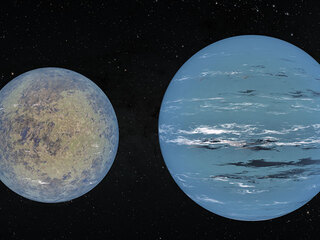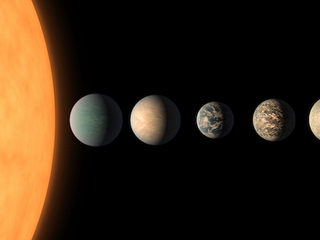News | February 16, 2016
Veteran astronomer joins JPL exoplanet team

Karl Stapelfeldt. Image credit: NASA/JPL
From Pat Brennan, JPL
Like many a planet-struck high-school student, Dr. Karl Stapelfeldt watched the Voyager spacecraft make their historic Jupiter flybys in 1979—and first became aware of NASA’s Jet Propulsion Laboratory. He even wrote a letter from his home in Florida asking how to get a job there.
And Stapelfeldt did make his way to JPL, first as a graduate student researcher and later as an employee working on a variety of projects: The WFPC2 camera for the Hubble Space Telescope, NASA’s Spitzer Space Telescope, and a proposed mission called the Terrestrial Planet Finder. Now, after a four-year stint at the Goddard Spaceflight Center in Greenbelt, Maryland, where he was chief of the Exoplanets and Stellar Astrophysics Laboratory, Stapelfeldt is returning to JPL.
A specialist in direct imaging of extrasolar planets—that is, planets circling stars other than our sun—Stapelfeldt will become the chief scientist for NASA’s Exoplanet Exploration Program, an arm of the NASA Astrophysics Division, helping to design state-of-the-art instruments for future space missions.
His timing couldn’t be better. JPL scientists are working on a new generation of space telescopes that should, in the years ahead, capture actual images of planets orbiting distant stars.
Stapelfeldt brings expertise and a long list of goals and ideas to his new position. He took a few moments recently to talk about the big picture and provide a preview of coming attractions.
Q. What are the goals of NASA’s Exoplanet program for the next decade?
A. For a long time the program's goal has been to fly missions that can discover Earth-like planets around other stars, and measure the properties of their atmospheres. Such planets might have water on their surfaces, they might be habitable, perhaps even have life. Let's find out! The program manages NASA's current exoplanet-related projects and develops the technologies needed for future missions to observe the most accessible targets, the stars in the sun’s immediate neighborhood.
The first exoplanet was only found 20 years ago, and since then we have detected relatively few exoplanets by way of direct imaging. To the layperson the most natural way to discover something is to actually see it. But for the most part, the exoplanets discovered so far are only known indirectly by the wobble of their host star, or dimming of the star as the planet passes in front. The indirect methods have been great—they’ve told us so many amazing things—but imaging is still our ultimate goal. It has the potential to find Earth-sized planets around stars like the sun, and measure their (atmospheric) spectra very clearly.
In the next 10 years a major first step is going to happen. We’ve been trying for more than a decade to get an imaging mission going. The first one will be the WFIRST (Wide-field Infrared Survey Telescope) mission that is starting now, and will be launched by the mid 2020s. That mission will carry an exoplanet imager on it, for the first time flying a dedicated instrument for this purpose. With the WFIRST instrument we intend to show that our approach to the problem will work in flight, and also get a taste of the science results that can come from it. So in the mid 2020s we should be seeing the reflected spectrum of Jupiter-like exoplanets, or even down at Neptune size—though not at Neptune’s distance from the sun.
Q. What is the next big step after that?
A. The WFIRST mission is not going to get us the goal I mentioned before: imaging Earth-like planets, and finding out if they are habitable and if they have water and possibly life. To accomplish that we need, really, a major new observatory. NASA is about to start a series of major mission studies, two of which will explore our options for that observatory. The Exoplanet Exploration Program Office here will support those studies. Eventually the 2020 Decadal Survey of Astronomy and Astrophysics will evaluate those studies and hopefully recommend one of them to go forward.
The new observatory may be designed to block the starlight using the WFIRST approach of an instrument held inside the telescope—a coronagraph— or alternatively use a different approach to blocking starlight, a starshade floating far in the distance along the sight line to the target star. These methods would be developed to the level where we could see a planet 10 billion times fainter than the target star.
Q. What is your vision for the program?
A. We need achievable and affordable options for space missions that can make progress in this problem, and get the whole national science community lined up behind them.
This is really the intersection of astrophysics and planetary science. We’re using the tools of astronomers—telescopes and their attached instruments—to extend planetary science to other solar systems. We want to get planetary scientists and astronomers together in this enterprise.
I hope to catalyze Goddard and JPL cooperation on this common goal. And following the precedent of Hubble, get other countries to join with us to achieve these challenging goals. I’d like to see an international effort.
The public is very excited by this problem of exoplanets. We see imaginary worlds all the time in science fiction. The missions we will be developing can take us from imagination to knowing what’s really out there. Exoplanet science combines key scientific questions with the public’s general enthusiasm for exploration.
Q. How did you first get interested in science and astronomy?
A. I was like many little kids affected by what I saw on television, both the reality of the Apollo program and the visions in science fiction. Both were inspiring. I have kindergarten drawings that show what was in my mind at the time. My dad got me a telescope at the right age and I just read all I could about this stuff.
I’ve always been interested in where planetary science and astrophysics come together. During my graduate years, we didn’t know of any exoplanets. The next best thing at that time was circumstellar disk material in orbit around a star—gas and dust clouds that might form a planetary system, or might be leftover from forming it. I started in my research career studying them.
Q. What science question intrigues you the most?
A. I would like to be able to understand the complete evolution of a planetary system, just as a geologist would like to see every stage in the evolution of a continent or a mountain. Knowing the processes that govern the formation, maturation, and eventual destruction of planetary systems is a prerequisite for understanding the prevalence of life in the universe.
Q. Any advice to young people considering a career in science or astronomy?
A. I think it’s one of the more rewarding things one could do. You’re pursuing knowledge for its own sake, especially in astronomy. It’s not one of the more practical things. The kind of satisfaction you get out of it is not really connected to financial reward; it’s understanding our place in the universe.
A whole bunch of NASA folks 40 years ago worked hard to make the Hubble telescope a reality, to get it started. I was lucky to be in position for the payoff from their efforts—to enjoy using that machine when it began operating on-orbit. So for young people, the message is that NASA right now is working to define your telescope, the telescope you will use when you are a researcher. So go to college and graduate school and become that researcher, so that you can take this machine and do great things with it.








